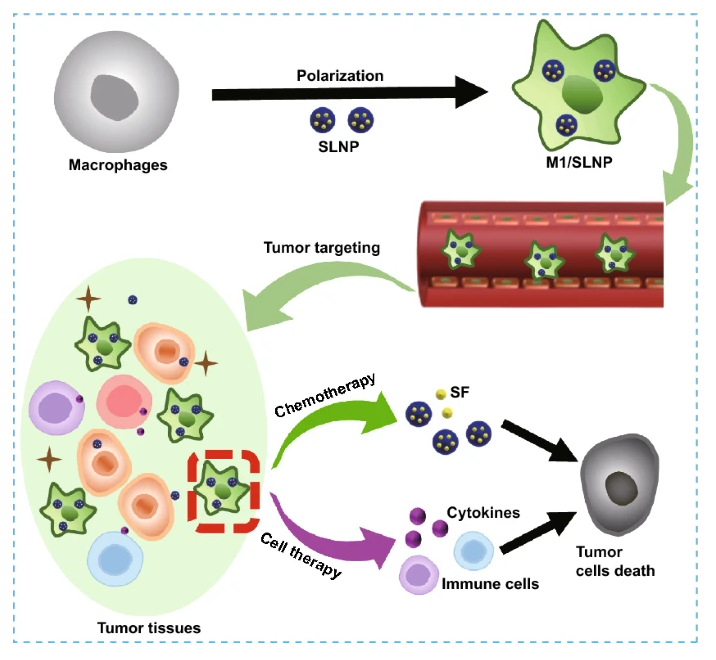文献:
Nanoparticle‑Loaded Polarized‑Macrophages for Enhanced Tumor Targeting and Cell‑Chemotherapy
文献链接:
https://link.springer.com/article/10.1007/s40820-020-00531-0
作者:
Teng Hou, Tianqi Wang, Weiwei Mu, Rui Yang, Shuang Liang, Zipeng Zhang, Shunli Fu, Tong Gao, Yongjun Liu & Na Zhang
相关产品:
磷脂-罗丹明B DSPE-RB DSPE-rhodamine B
原文摘要:
Cell therapy is a promising strategy for cancer therapy. However, its therapeutic efficiency remains limited due to the complex and immunosuppressive nature of tumor microenvironments. In this study, the “cell-chemotherapy” strategy was presented to enhance antitumor efficacy. M1-type macrophages, which are therapeutic immune cells with both of immunotherapeutic ability and targeting ability, carried sorafenib (SF)-loaded lipid nanoparticles (M1/SLNPs) were developed. M1-type macrophages were used both as therapeutic tool to provide immunotherapy and as delivery vessel to target deliver SF to tumor tissues for chemotherapy simultaneously. M1-type macrophages were obtained by polarizing macrophages using lipopolysaccharide, and M1/SLNPs were obtained by incubating M1-type macrophages with SLNP. Tumor accumulation of M1/SLNP was increased compared with SLNP (p < 0.01), which proved M1/SLNP could enhance tumor targeting of SF. An increased ratio of M1-type macrophages to M2-type macrophages, and the CD3+CD4+ T cells and CD3+CD8+ T cell quantities in tumor tissues after treatment with M1/SLNP indicated M1/SLNP could relieve the immunosuppressive tumor microenvironments. The tumor volumes in the M1/SLNP group were significantly smaller than those in the SLNP group (p < 0.01), indicating M1/SLNP exhibited enhanced antitumor efficacy. Consequently, M1/SLNP showed great potential as a novel cell-chemotherapeutic strategy combining both cell therapy and targeting chemotherapy.

M1型巨噬细胞是一种具有靶向能力的免疫细胞,携带(SF)负载的脂质纳米粒子(M1/SLNPs)。M1型巨噬细胞通过使用脂多糖极化巨噬细胞而获得,M1/SLNP通过将M1型巨噬细胞与SLNP孵育而获得。

图为:aM1/SLNP的制备。bM1/SLNP用于靶向传递以增强效果的示意图
制备方法:采用SLNP在M/SLNP或M1/SLNP CLSM和TEM中的稳定性来评价SLNP在M/SLNP或M1/SLNP中的稳定性。将DSPE-罗丹明B和大豆卵磷脂溶解在Tween-80水溶液中(1.5%,w/v)中,其他方法与C6-LNP相似。因此,获得了C6-LNP,其中用罗丹明b快速标记LNP,巨噬细胞在12孔板中培养过夜。将巨噬细胞与LPS(1µg mL−1)孵育24 h,获得m1型巨噬细胞。加入C6-LNPs,与巨噬细胞或m1型巨噬细胞孵育2h。PBS洗涤后,细胞与添加10%胎牛血清的新鲜DMEM培养基中孵育不同的时间(0、4、8、12和24 h)。在预定的时间点,用PBS洗涤细胞,并在CLSM下观察。并在24 h后获得细胞,并在透射电镜下观察。
M1/SLNP的Tumor 积聚较SLNP增加(p < 0.01),证明M1/SLNP能增强SF的Tumor 靶向性。M1/SLNPTreatment后,M1型巨噬细胞与M2型巨噬细胞的比例增加,Tumor 组织中CD3+CD4+T细胞和CD3+CD8+T细胞的数量增加,表明M1/SLNP可以缓解免疫抑制性Tumor 微环境。M1/SLNP组的Tumor 体积明显小于SLNP组(p < 0.01),表明M1/SLNP表现出增强s的抗Tumor 功效。因此,M1/SLNP作为一种结合细胞Treatment和靶向Chemotherapy的新型细胞Chemotherapy策略显示出巨大的潜力。

 2024-11-18 作者:wff 来源:https://link.springer.com/article/10.1007/s40820-020-00531-0
2024-11-18 作者:wff 来源:https://link.springer.com/article/10.1007/s40820-020-00531-0

